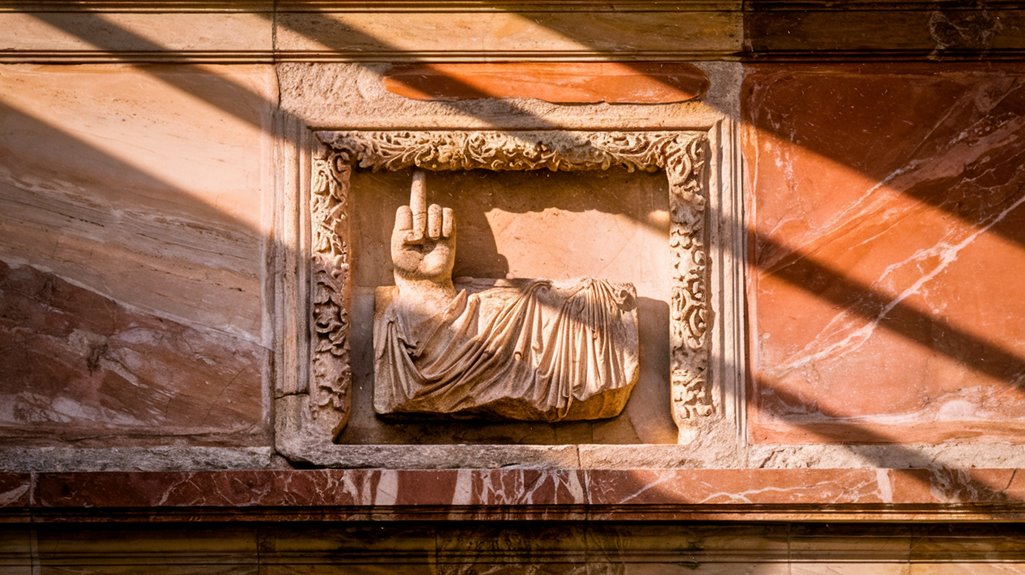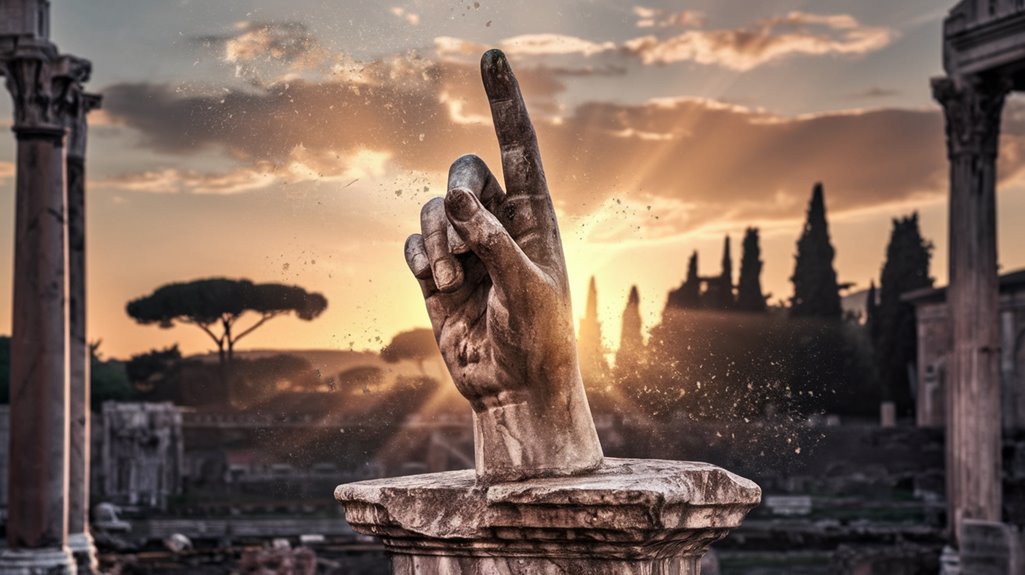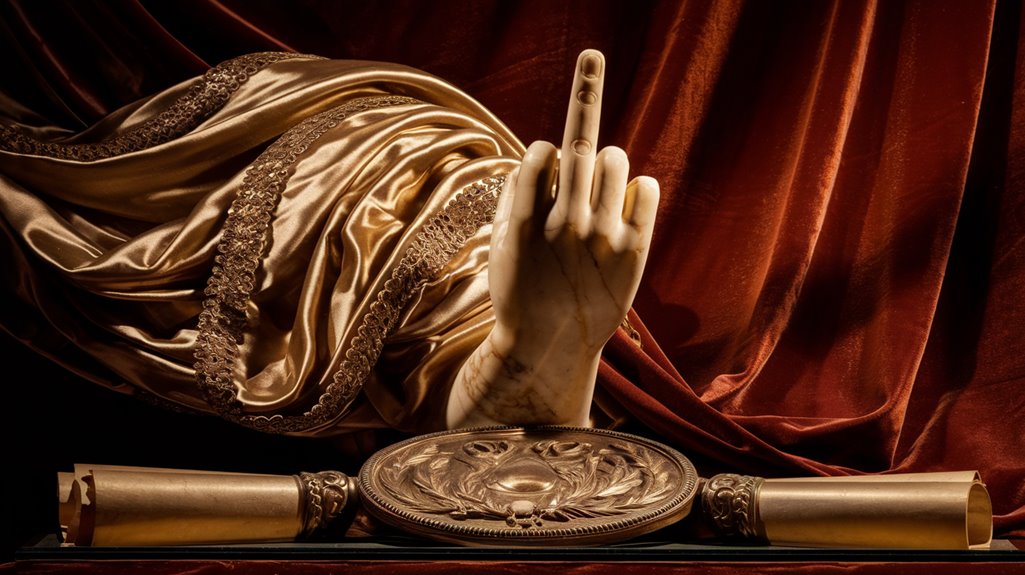The Middle Finger: Ancient Rome’s Biggest Insult
Just as Zeus hurled thunderbolts from Mount Olympus, ancient Romans wielded a different kind of weapon: the infamous middle finger. You've likely used this gesture yourself, but you might not know that you're carrying on a tradition that spans over two millennia. While today's obscene hand signals can land you in trouble, in ancient Rome, this digit-based insult carried enough weight to offend emperors and spark political upheaval. There's more to this simple gesture than you'd expect.
Ancient Origins: From Protection to Profanity

While many ancient gestures have lost their meaning over time, the notorious middle finger has maintained its power to offend for over two millennia. Known in Latin as the "digitus impudicus" or shameless finger, this gesture's evolution traces back to ancient Rome, where its phallic symbolism made it a potent form of disrespect. The historical examination needed suggests we should be cautious about assuming modern interpretations match ancient uses.
You'll find evidence of its insult significance throughout Roman history. Emperor Augustus was so offended by an actor's use of the middle finger that he banished the performer from Rome. The first recorded use of this gesture appeared in the Greek play "Clouds" around 419 BC.
Even the infamous Caligula weaponized the gesture, forcing his subjects to kiss his extended middle finger as a form of humiliation.
The gesture's meaning was so deeply embedded in Roman culture that scholars like Isidore of Seville documented its use in accusing others of "shameful action."
The Sacred and Profane: Greek Influence on Roman Gestures
Despite their reputation for cultural innovation, the Romans borrowed heavily from Greek traditions when it came to hand gestures and body language. This influence would later shape how hand positions conveyed authority in both religious icons and public speaking. While Greek rituals influenced many Roman adaptations of hand signals, the Romans developed their own distinct interpretations, often making gestures more formal and structured to reflect their hierarchical society. Historical records from Aristophanes show that rude finger gestures existed in Greek society long before Roman adoption.
- The "dextrarum iunctio" (joining right hands) symbolized unity in both cultures but gained particular significance in Roman marriage ceremonies.
- The "supinae manus" prayer position evolved from Greek practices into a distinctly Roman expression of religious devotion.
- Roman orators adapted Greek rhetorical gestures but added more rigid, authoritative movements.
- The offensive middle finger gesture, while documented in both cultures, became particularly prominent in Roman literature and daily life.
These shared customs highlight how Rome transformed Greek cultural elements into their own unique expressions of power and social interaction.
Political Power of the Middle Finger in Rome
Throughout ancient Rome, the middle finger gesture carried such potent political weight that even emperors wielded it as a tool of power and humiliation.
Originally, the ancient Romans actually saw the middle finger as a protective symbol against evil forces, making its evolution into an insult even more remarkable.
The Romans referred to this gesture as the digitus impudicus, reflecting its deeply offensive nature in their society.
You'd find this political symbolism most evident in how emperors like Caligula forced subjects to kiss his middle finger instead of his hand, deliberately undermining the traditional social hierarchy of Rome.
The consequences of using this gesture were severe, especially for those who dared challenge authority.
When the actor Pylades directed his middle finger at a heckling audience member, Emperor Augustus didn't hesitate to banish him from Rome and Italy.
The gesture's power extended beyond the empire's borders, with German tribesmen using it to taunt Roman soldiers, proving that even Rome's enemies understood its profound ability to provoke and insult.
Documented Evidence in Classical Literature
Ancient Greek and Roman literature provides a treasure trove of references to the middle finger gesture, with some of the earliest documented examples appearing in Aristophanes's comedic plays.
Through literary symbolism and cultural evolution, you'll find the gesture documented as the "katapugon" in Greek texts and the "digitus impudicus" in Roman writings, showcasing its significance in classical society.
The gesture held deep cultural meaning as an apotropaic symbol, believed to ward off evil spirits and misfortune in ancient times.
- Aristophanes used it as a comedic device in "The Clouds" and "Peace" to express mockery
- Diogenes of Sinope famously insulted Demosthenes with the gesture
- Roman writers Martial and Juvenal incorporated it in their works as a symbol of contempt
- Emperor Caligula transformed it into a tool of humiliation by forcing subjects to kiss his middle finger
The gesture's documentation in classical literature demonstrates its enduring power as a universal symbol of defiance.
Latin Insults and Their Cultural Context

In the ruthless arena of Roman public life, insults served as powerful weapons that could make or break political careers. While you might think ancient Romans had no boundaries, there was actually a complex insult etiquette that governed these verbal attacks.
Public perception played a vital role in how insults were delivered and received. You'd find senators hurling accusations of crimes and moral offenses at each other, using terms like "carnifex" (executioner) or "mastigia" (deserving the lash). Cicero exemplified this practice by calling a fellow senator a nutricula seditiosorum omnium. The practice of harsh invectives actually helped create group solidarity among political factions.
The public could freely insult politicians in assemblies, but the elite had to be careful when directing invectives at common citizens.
Urban wit, known as urbanitas, elevated these exchanges beyond mere mudslinging. Sexual behavior, cleanliness, and mental capacity were common targets, with colorful phrases like "foetorem extremae latrinae" (sewer stench) highlighting Roman creativity in verbal warfare.
The Gesture's Journey Through Time
While Romans hurled verbal insults with calculated precision, their most enduring contribution to the art of offense came in the form of a simple hand gesture.
The middle finger's gesture evolution spans from ancient Rome's spiritual ward against evil to Greece's provocative symbol of male anatomy. Through cultural adaptation, it transformed from a mystical sign into a universal expression of contempt.
- Ancient Rome called it "digitus impudicus" (shameless finger), using it in both spiritual and insulting contexts
- Greek philosophers and actors popularized its use as a sign of disdain
- Emperor Caligula weaponized the gesture to humiliate his subjects
- By the 19th century, it had shed its religious origins to become purely offensive
Today, you'll find this gesture transcends language barriers, serving as a powerful reminder of humanity's enduring ability to communicate displeasure.










